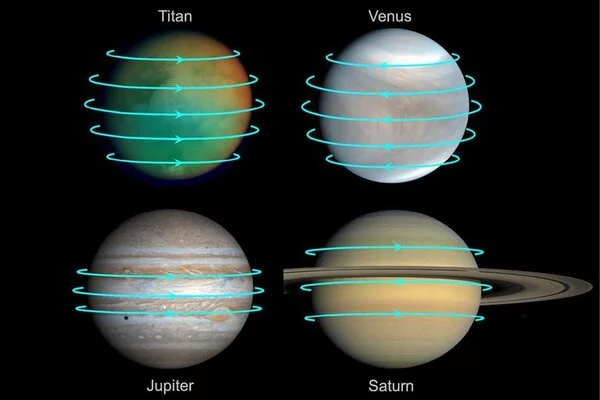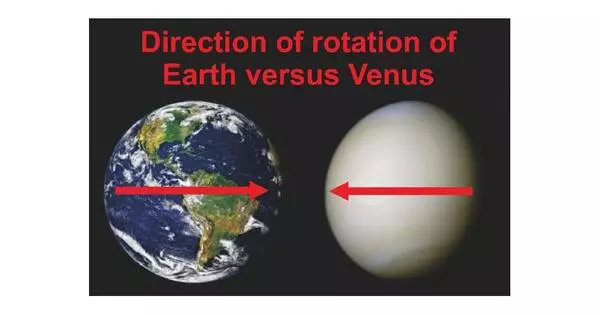An international research team discovered that the ‘super-rotation’ of Venus is maintained near the equator by atmospheric tidal waves formed by solar heating on the planet’s dayside and cooling on the planet’s nightside. Venus’s solid surface rotates slowly, once every 243 days, but its thick atmosphere circles the planet in only four days. To overcome friction with the surface, this phenomenon, known as super-rotation, requires a continuous input of angular momentum from an unknown source.
Images from the Akatsuki spacecraft reveal what causes Venus’s atmosphere to rotate at a much faster rate than the planet itself. The thick atmosphere of Venus rotates 60 times faster than the surface, a phenomenon known as super-rotation.
An international research team led by Takeshi Horinouchi of Hokkaido University has revealed that this ‘super-rotation’ is maintained near the equator by atmospheric tidal waves formed from solar heating on the planet’s dayside and cooling on its nightside. Closer to the poles, however, atmospheric turbulence and other kinds of waves have a more pronounced effect. The study was published online in Science.
Our research could help us better understand atmospheric systems on tidally-locked exoplanets with one side always facing the central stars, similar to Venus’s very long solar day. Findings uncovered the factors that sustain the super-rotation while proposing a dual circulation system that effectively transports heat across the globe.
Takeshi Horinouchi
Venus rotates very slowly, taking 243 Earth days to complete one rotation around its axis. Despite its slow rotation, Venus’ atmosphere rotates westward 60 times faster than the planet itself. This super-rotation accelerates with altitude, taking only four Earth days to circle the entire planet to the top of the cloud cover. The planet’s fast-moving atmosphere transports heat from the dayside to the night side, reducing temperature differences between the two hemispheres. “However, since the super-rotation was discovered in the 1960s, the mechanism behind its formation and maintenance has remained a long-standing secret,” says Horinouchi.
Horinouchi and his colleagues from the Institute of Space and Astronautical Science (ISAS, JAXA) and other institutes developed a new, highly precise method to track clouds and derive wind velocities from images provided by ultraviolet and infrared cameras on the Akatsuki spacecraft, which began its orbit of Venus in December 2015. This allowed them to estimate the contributions of atmospheric waves and turbulence to the super-rotation.

The group first noticed that the temperature differences between low and high latitudes are so small that they cannot be explained without a cross-latitude circulation. “Because such circulation should change the wind distribution and weaken the super-rotation peak, it also implies that there is another mechanism that reinforces and maintains the observed wind distribution,” Horinouchi said. Further investigation revealed that the thermal tide – an atmospheric wave caused by the difference in solar heating between the day and night – provides the acceleration at low latitudes.
Earlier studies proposed that atmospheric turbulence and waves other than the thermal tide may provide acceleration. However, the current study showed that they work oppositely to weakly decelerate the super-rotation at low latitudes, even though they play an important role at mid-to-high latitudes.
It has a mean temperature of 462°C. This is due to the high concentration of carbon dioxide in Venus’ atmosphere, which creates an intense greenhouse effect. Heat is trapped in the atmosphere like a blanket, causing the planet’s temperature to be much higher than its proximity to the Sun would suggest. The sulphuric acid clouds in Venus’ atmosphere make it reflective and shiny, obscuring our view of its surface. Its brightness makes it visible even during the day if the sky is clear and you know where to look.
Their findings uncovered the factors that sustain the super-rotation while proposing a dual circulation system that effectively transports heat across the globe: the meridional circulation, which slowly transports heat to the poles, and the super-rotation, which rapidly transports heat to the planet’s nightside.
“Our research could help us better understand atmospheric systems on tidally-locked exoplanets with one side always facing the central stars, similar to Venus’s very long solar day,” Horinouchi added.
















